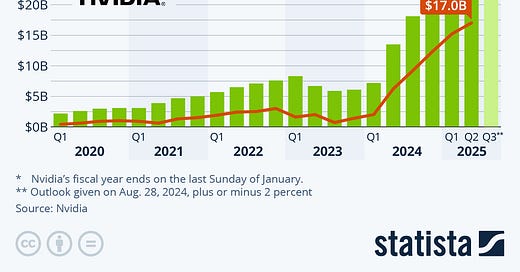Making Hay (Almost) Monday - September 3rd, 2024
High-level macro-market insights, actionable economic forecasts, and plenty of friendly candor to give you a fighting chance in the day's financial fray.
Charts of the Week
It could be called the curse of Great Expectations. It’s not often you see a stock decline over 6% the day after reporting sales and profits both increased by more than 100%. Due to the fact it has consistently blown past Wall Street’s estimates over the last year and a half, merely meeting lofty forecasts wasn’t good enough. While 6% might not seem like a big decline, in dollar terms that amounted to roughly a $200 billion market value evaporation. Should the growth rate slow to something still outstanding, but more in the realm of the typical high growth stock, like 30%, the valuation retrenchment could easily equal what it saw from early-July to early-August. That was when it fell from 135 to 98, or 27%.
There are legitimate fears that the yen’s brawny rally over the last two months might seriously wound its stock market. This is because a higher yen could easily mean lower profits for its critical export sector. Many, if not most, of its blue-chip companies have markedly benefited from the cheap yen that has made their products ultra-competitive on world markets. However, this has been at least partially mitigated by the reality that most Japanese export powerhouses, like Toyota, maintain substantial production facilities in the markets they serve, such as the U.S. What also could be a powerful supporting factor for Japan’s stock market is the low level of stock exposure its households have, as well as their immense cash holdings.
As you can see above, while U.S. households have 56% of their financial assets in securities (i.e., stocks and bonds), the Japanese consumer has a mere 21% in such; of that, just 13% is in equities. Impressively, they hold currency and deposits — essentially, cash — equal to over 50% of their total financial assets. If they suspect that the yen has much further to recover, they may repatriate some of their vast overseas holdings and recycle a substantial portion of that into their still-depressed stock market.
“We believe the uranium bull market is far from over. Production shortfalls will fuel the next phase.” -Goehring & Rozencwajg, August 22nd, 2024
“I don’t know about the next week or even the next month, but the A.I. bubble is deflating. At best, [NVDA] is a trading sardine. At worst, it’s in a secular bear market. 40x sales will prove this generation’s McNealy-what-were-you-thinking-moment.” -Kevin Muir, the MacroTourist
You Too, U2?
When younger boomers and older Millennials hear or read U2 they typically think of an Irish rock band that has been around for almost 50 years. As many who populate these contiguous generations are aware, its lead vocalist is Bono, and he has attained true superstar status. Yet, what most of its legions of fans may not know is that the band never liked the name U2. They chose it because of all the “handles” they were considering to replace their original name, Hype, Bono and his mates disliked it the least.
That dismissive attitude is appropriate for the far less famous U2 that is often used as shorthand for uranium. In the minds of the majority of environmentalists and government policymakers, U2 is the traditional energy source they dislike the least. Even that ambivalence is a relatively recent development. For decades, the environmental movement displayed an unabashedly hostile attitude toward nuclear energy.
In reality, the uranium that really matters to atomic power is U-235. But that wouldn’t have been nearly as catchy a name for a rock band, right? Yet, that particular radioactive rock only amounts to less than 1% of the uranium that is mined around the world. (If you care, the much more plentiful element is U-238.) In other words, it could be considered a rare earth element and, as we will soon see, it’s becoming rarer by the day.
This newsletter first highlighted the main uranium ETF, the Sprott Physical Uranium Trust (SRUUF), in June of last year. Our thesis even back then was that U-235 demand was outstripping supply and that this trend was poised to continue. It was trading around $12 at that time and was destined to hit $25 in February of this year. Along the way we suggested some profit-taking but, candidly, it wasn’t a very emphatic trim recommendation. The reason for that subdued attitude was because of U-235; we were coming to the realization that demand was even stronger, and supply more challenged, than we initially believed.





